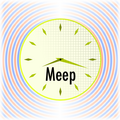Perfectly matched layer
From AbInitio
| Revision as of 19:46, 7 November 2005 (edit) Stevenj (Talk | contribs) ← Previous diff |
Revision as of 21:59, 7 November 2005 (edit) Stevenj (Talk | contribs) Next diff → |
||
| Line 5: | Line 5: | ||
| The finite-difference implementation of PML requires the conductivities to be turned on gradually over a distance of a few grid points to avoid numerical reflections from the discontinuity. | The finite-difference implementation of PML requires the conductivities to be turned on gradually over a distance of a few grid points to avoid numerical reflections from the discontinuity. | ||
| + | |||
| + | {{stub}} | ||
| [[Category:Meep]] | [[Category:Meep]] | ||
Revision as of 21:59, 7 November 2005
| Meep |
| Download |
| Release notes |
| FAQ |
| Meep manual |
| Introduction |
| Installation |
| Tutorial |
| Reference |
| C++ Tutorial |
| C++ Reference |
| Acknowledgements |
| License and Copyright |
The perfectly matched layer (PML) approach to implementing absorbing boundary conditions in FDTD codes was proposed by Berenger in 1994 (see [1]). The approach involves surrounding the computational cell with a medium that in theory absorbs without any reflection electromagnetic waves at all frequencies and angles of incidence. Berenger showed that such a medium can be constructed as a lossy anisotropic dielectric with electric and magnetic conductivities of equal magnitude. (Of course, the magnetic conductivity requirement makes this an unphysical medium.)
The finite-difference implementation of PML requires the conductivities to be turned on gradually over a distance of a few grid points to avoid numerical reflections from the discontinuity.
- This page is a stub — a placeholder for a more complete article to be added in the future.

